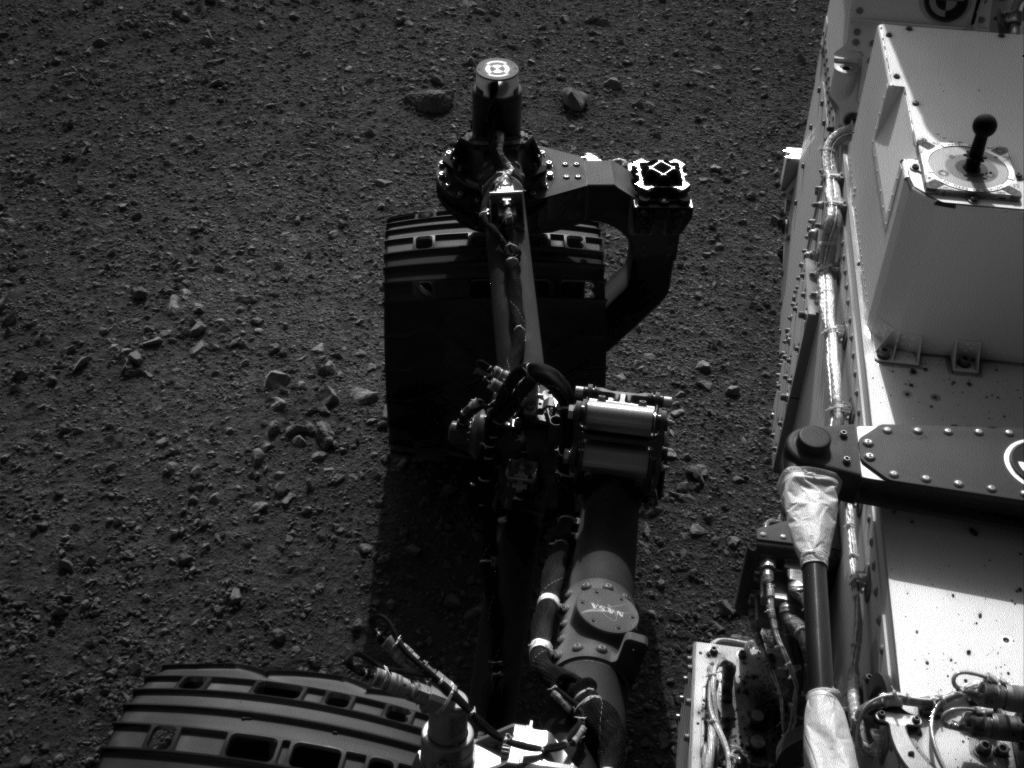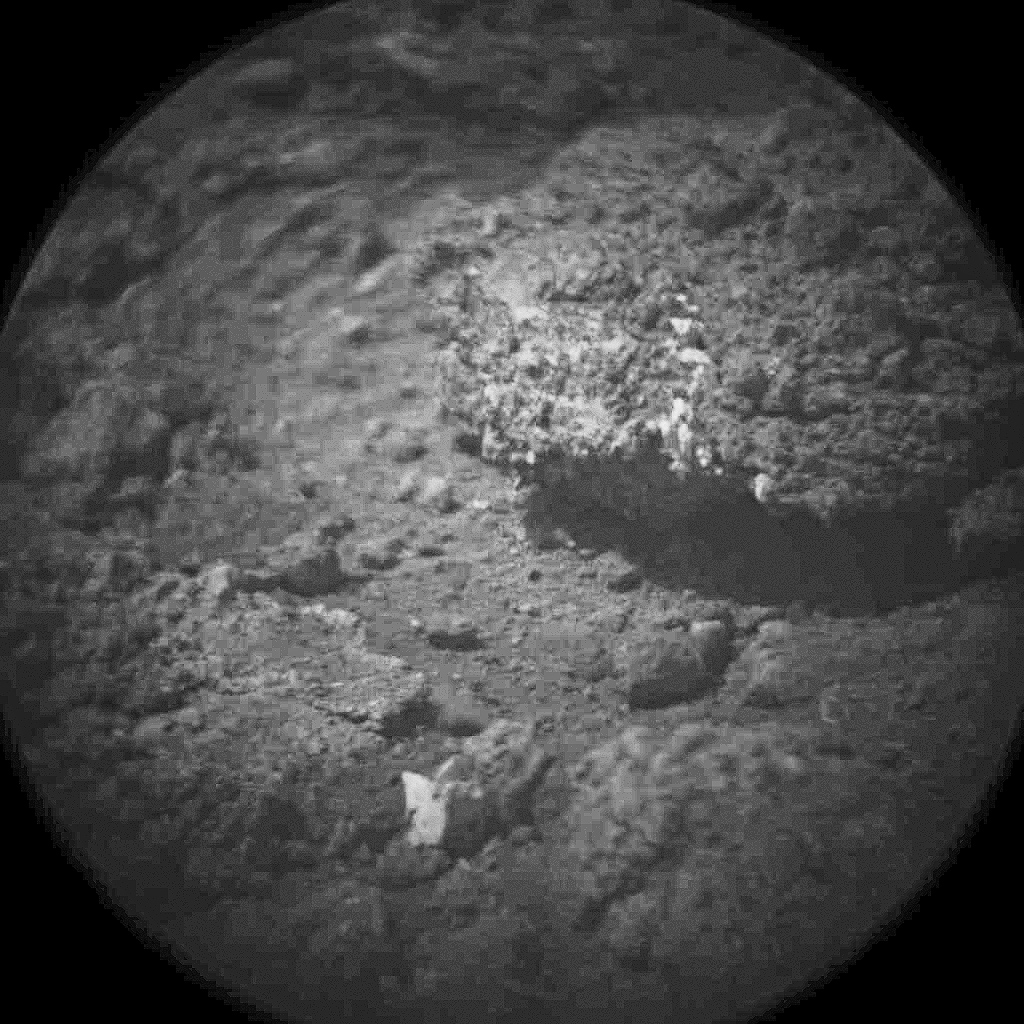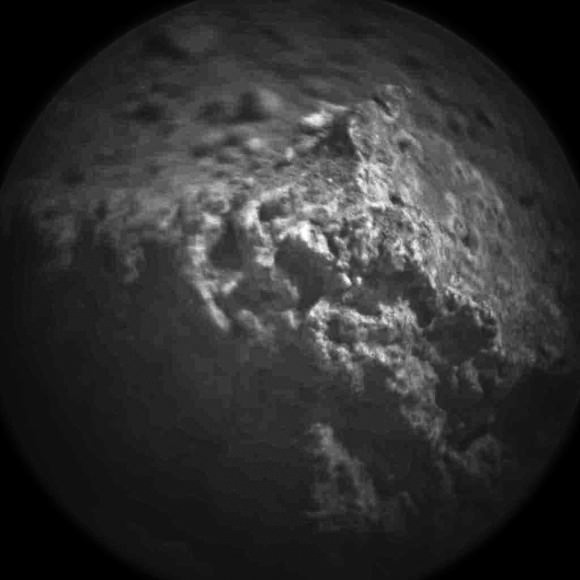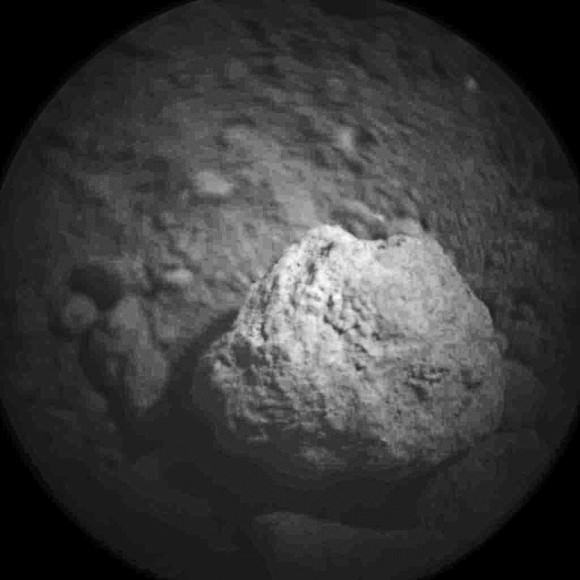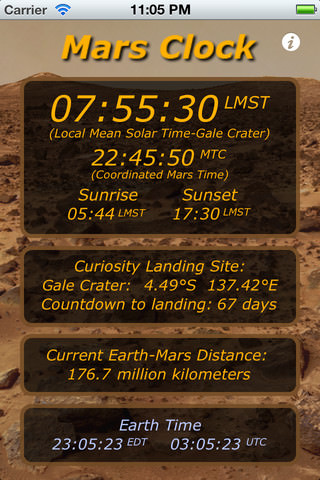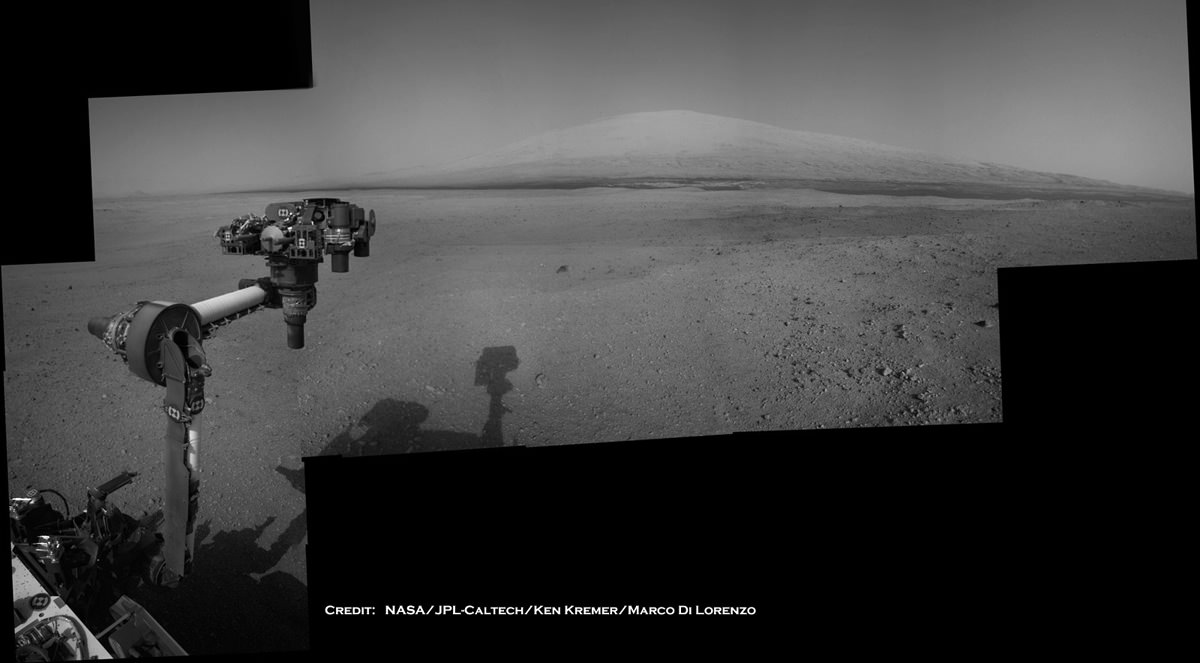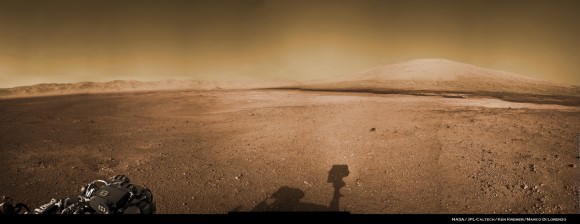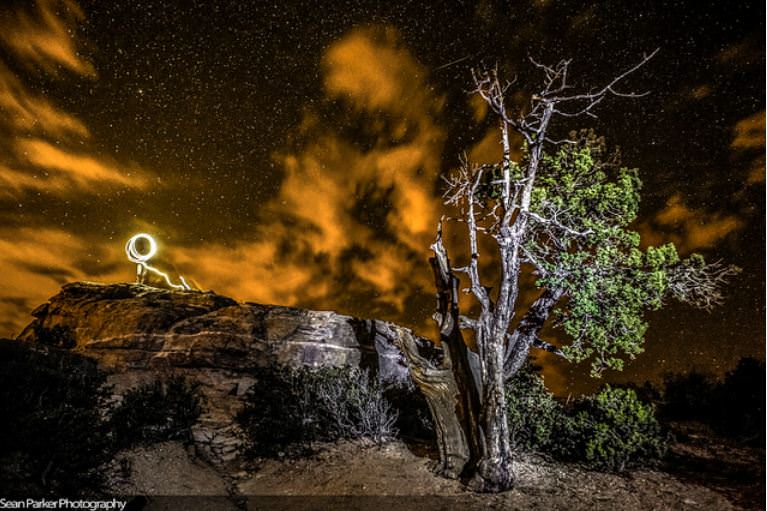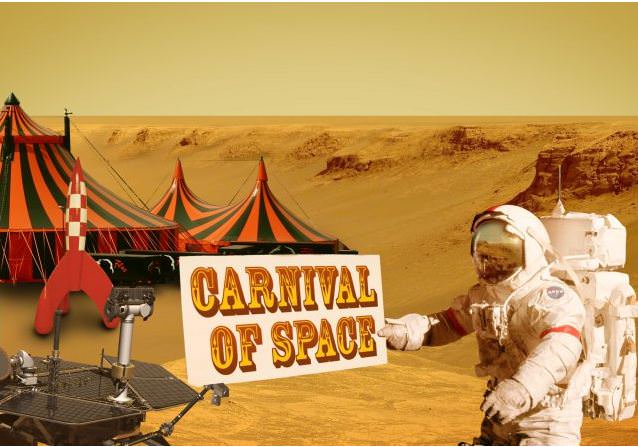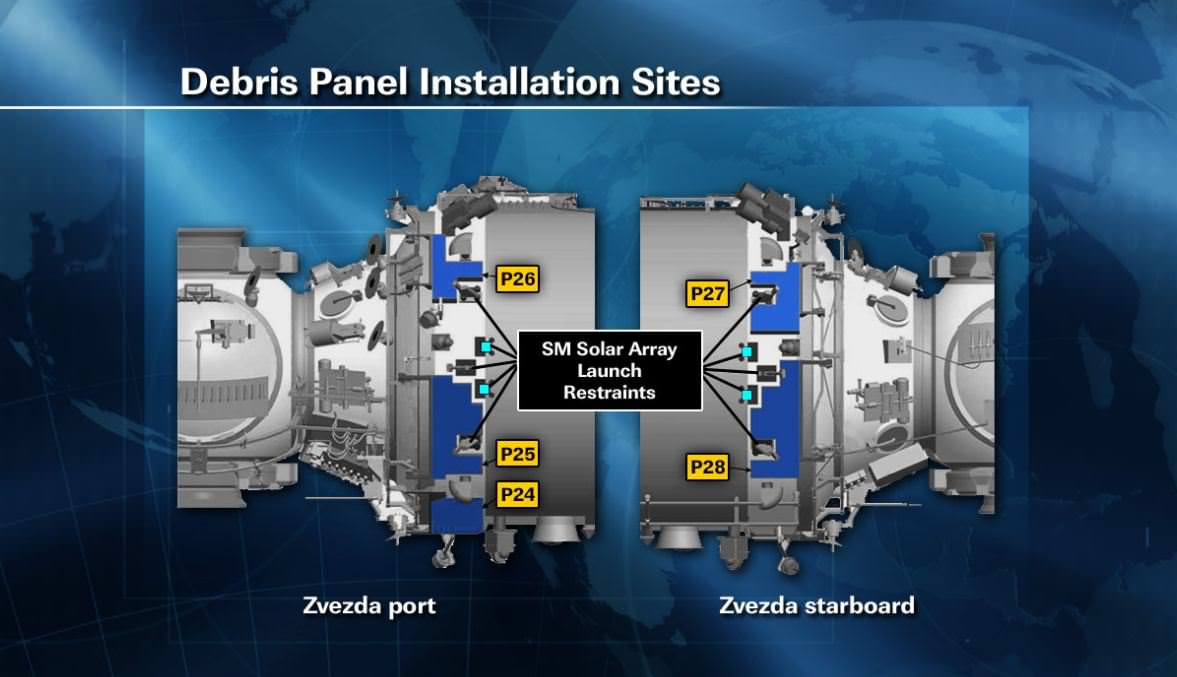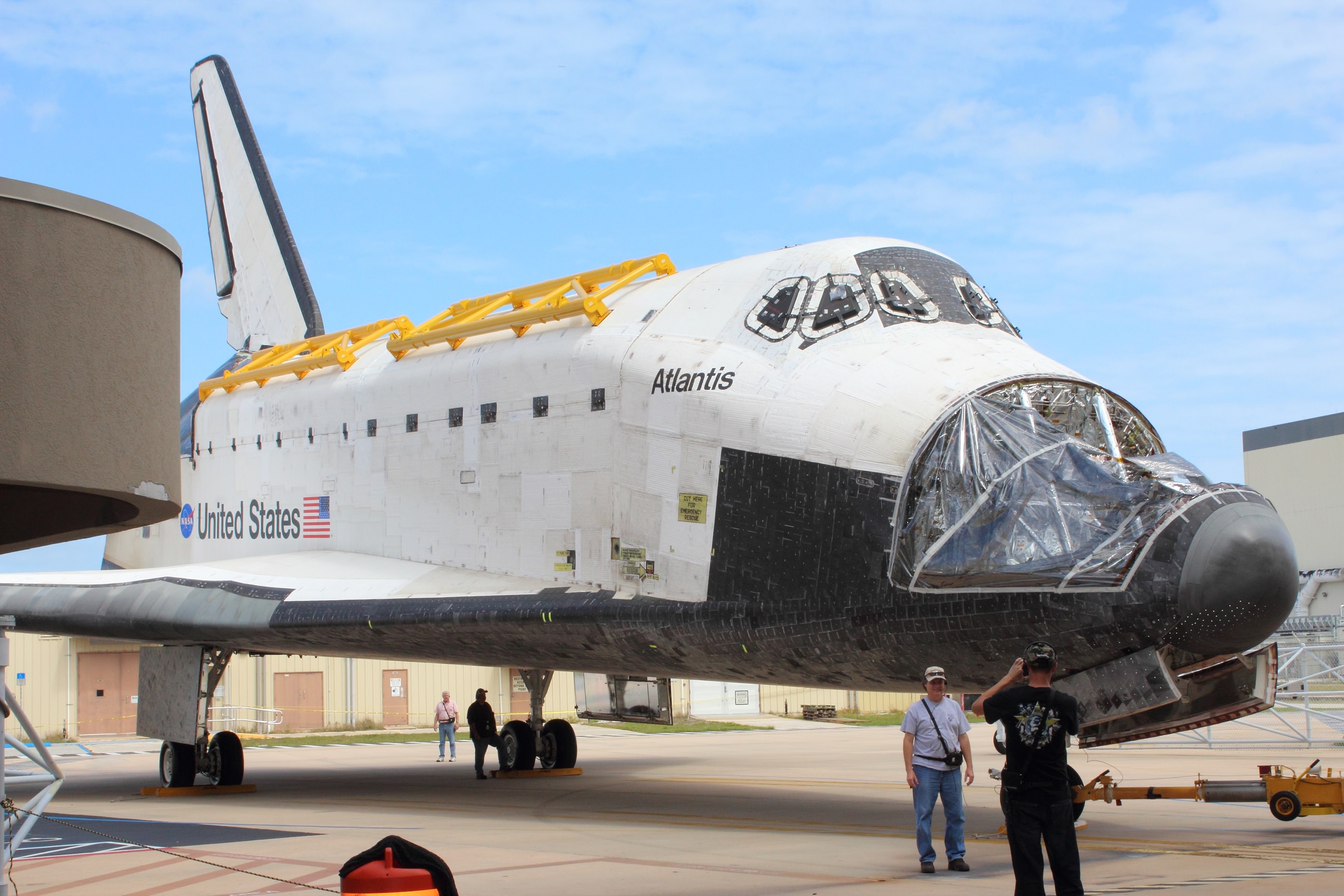It keeps getting better! This is a full-resolution version of the NASA Curiosity rover descent to Mars, taken by the MARDI descent imager. This video, put together by Daniel Luke Fitch, uses all but a dozen of the full resolution 1600×1200 frames (some haven’t been uploaded from the rover yet). The result is a mind-blowing, HD view of Curiosity’s view as it landed — and it also shows the best views yet of the heat shield impact. Wow!
Watch Curiosity’s First Movements
Click to animate: this gif image shows the movement of the rear right wheel of NASA’s Curiosity as rover drivers turned the wheels in place at the landing site on Mars. Image credit:NASA/JPL-Caltech
She turned her right rear wheel in and turned her right rear wheel out in a sort of Hokey-Pokey-like action in preparation for actually moving inside Gale Crater. Yesterday, the Curiosity rover’s first movements was this “wiggle” of each of the four corner wheels for the first time. Curiosity Mission Manager Michael Watkins said this was a test of the steering actuators on the wheels, and was critical preparation for Curiosity’s first drive on Mars.
Late last night, the rover team sent commands for doing the first drive, and we’ll likely have information on whether that first drive was successful, as JPL has a news conference planned for 17:00 UTC, 1 pm EDT on Wednesday.
Below is a video animation of the rover’s first arm movements, as well:
Other news from the press conference yesterday is that all the instruments are working well on the rover so far, except for one of the instruments on the weather station.
One of the two sets of Rover Environmental Monitoring Station (REMS) wind sensors is not providing data. “One possibility is that pebbles lofted during the landing hit the delicate circuit boards on one of the two REMS booms,” said Curiosity Deputy Project Scientist Ashwin Vasavada of NASA’s Jet Propulsion Laboratory, Pasadena, Calif. “We will have to be more clever about using the remaining wind sensor to get wind speed and direction.”
The rover’s weather station, build by researchers in Spain, checks air temperature, ground temperature, air pressure, wind and other variables every hour at the landing site in Gale Crater. On a typical Martian day, or “sol,” based on measurements so far in the two-week old mission, air temperatures swing from minus 2 to minus 75 Celsius (28 degrees to minus 103 degrees Fahrenheit). Ground temperatures change even more between afternoon and pre-dawn morning, from 3 to minus 91 Celsius (37 degrees to minus 132 degrees Fahrenheit ).
“We will learn about changes from day to day and season to season,” said Javier Gómez-Elvira of the Centro de Astrobiología, Madrid, Spain, principal investigator for REMS.
The team predicts that within a week or so, daily Mars weather reports from Curiosity will become available at this website: http://cab.inta-csic.es/rems/marsweather.html or bit.ly/RzQe6p.
Another instrument provided by Russia is checking for water bound into minerals in the top one meter (three feet) of soil beneath the rover. It employs a technology that is used in oil prospecting on Earth, but had never before been sent to another planet.
“Curiosity has begun shooting neutrons into the ground,” said Igor Mitrofanov of Space Research Institute, Moscow, principal investigator for this instrument, called the Dynamic Albedo of Neutrons, or DAN. “We measure the amount of hydrogen in the soil by observing how the neutrons are scattered, and hydrogen on Mars is an indicator of water.”
The most likely hydrogen to be found in shallow ground of Gale Crater, near the Martian equator, is in hydrated minerals. These are minerals with water molecules, or related ions, bound into the crystalline structure of rocks. They can tenaciously retain water from a wetter past after all free water has gone.
With plans for Curiosity to begin roving, there will soon be new places for all the instruments to measure. The rover team explained the first real drive today will be a very simple execution: forward about 3 meters, then a turn in place of 90 degrees to the right, then a 2-meter drive backwards. Estimates are the rover will end up about 3 meters from its current position and be facing south instead of east.
Emily Lakdawalla has a nice 4-view animation of the rover’s wheel wiggle, showing three wheels and how the shadow of the rover itself moved.
Take a Look Through Curiosity’s ChemCam
This (adjusted) image was taken by ChemCam’s Remote Micro-Imager on Sol 15 (NASA/JPL-Caltech/LANL)
While Curiosity has been getting a good look around its landing spot on Mars, taking in the sights and sending back some impressive views of distant hills and Gale Crater’s enormous central peak, it’s also been peering very closely at some tiny targets just meters away — with its head-mounted, laser-powered and much-touted ChemCam.
The images above and below were acquired by ChemCam’s Remote Micro-Imager on August 21, the 15th “Sol” of the mission. A full-sized image accessed from the public MSL mission site, it’s been brightened quite a bit to show the details of the target rocks.
Mounted to Curiosity’s “head”, just above its Mastcam camera “eyes”, ChemCam combines a powerful laser with a telescope and spectrometer that can analyze the light emitted by zapped materials, thereby determining with unprecedented precision what Mars’ rocks are really made of.
So even though the rover hasn’t actually roved anywhere yet, it’s still performing valuable scientific investigations of Mars — without moving a single wheel. (UPDATE: actually, Curiosity has begun to do some roving — here are some images of its first wheel tracks!)
Read: Curiosity Blasts First Mars Rock with Powerful Laser Zapper
Because ChemCam uses a laser, Curiosity can examine many targets — up to a dozen — within a small time period without having to drive right up to them. Even the dustiest rocks won’t pose a problem for ChemCam – one or two zaps with its laser will be enough to vaporize any loose surface material.
In addition to searching for the building blocks of life hidden inside rocks, ChemCam will also serve a precautionary role for future explorers by helping identify the potential toxicity of Mars’ soil and dust. When astronauts one day land on Mars, they are going to get dusty. It’s important to know if Mars’ dust contains anything dangerous like lead, arsenic (and who knows what else!)
See the latest images from the MSL mission — including more ChemCam pictures — here.
Images: NASA/JPL-Caltech/LANL. Edited by J. Major.
Want To Live On Mars Time? There’s An App For That
Screenview from Mars Clock, available from the Apple Store, that displays Mars time.
You’ve listened to all of JPL’s Curiosity telecons, you can recite the nail-biting sequence of events during MSL’s “Seven Minutes of Terror,” and you’ve devoured thousands of pixels of image data beamed back to Earth. But are you ready to live on Mars time? With a couple of well-timed apps from Google Play and Apple’s app store, you can.
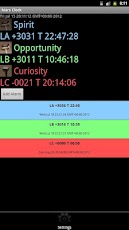 MarsClock, available for Android devices at Google play is a free app written by Scott Maxwell, rover driver for Curiosity. The app, which has been downloaded between 1,000 and 5,000 times, lets you see times for all three of NASA’s Mars Rovers, Spirit, Opportunity and Curiosity. The app allows the user to set single alarms or alarms that repeat every sol. A sol is a full Martian day which is about 24 hours, 39 minutes in Earth time.
MarsClock, available for Android devices at Google play is a free app written by Scott Maxwell, rover driver for Curiosity. The app, which has been downloaded between 1,000 and 5,000 times, lets you see times for all three of NASA’s Mars Rovers, Spirit, Opportunity and Curiosity. The app allows the user to set single alarms or alarms that repeat every sol. A sol is a full Martian day which is about 24 hours, 39 minutes in Earth time.
Perhaps you shun Android devices for your Apple device whether it’s an iPhone, iPad or iPod. Never fear, you too can be everyone’s favorite Martian living on Mars time. Mars Clock, by SunlightAndTime, is a 99-cent app that displays Mars time and a host of other Mars time goodies. Features include local mean solar time for the rover, coordinated Mars time, sunrise and sunset times for the Curiosity landing site (I think this might be the coolest feature), current season, a countdown to landing feature (which is counting up since MSL landed on Mars on August 5th), current Earth time, a distance calculator between the Earth and Mars and radio communications delay estimate.
While it might be hard to add 40 minutes to your day to live as a Martian or as the JPL team that operates the Curiosity rover, these apps sure do make it more fun.
Curiosity Takes Aim at Martian Destination – Mount Sharp
Image Caption: Curiosity Points to Mount Sharp. Curiosity unstowed the robotic arm on Aug. 20 and aimed it directly at her Martian drive destination – Mount Sharp. This mosaic of the robotic arm was assembled from navigation camera images from Sols 2, 12 and 14 and shows 18,000 foot high Mount Sharp in the background and the shadow of the martian robot’s head at center. Curiosity will search for hydrated minerals using the robotic arm and a neutron detector on the body. Image stitching and processing by Ken Kremer and Marco Di Lorenzo. Credit: NASA/JPL-Caltech/Ken Kremer/Marco Di Lorenzo
Curiosity flexed her mighty robotic arm for the first time on Monday (Aug. 20) and aimed the hand-like tool turret squarely at Mount Sharp, her ultimate driving destination.
If you want to see exactly where Curiosity is headed and why she was sent to Gale Crater, just take a look at the new mosaic assembled by Ken Kremer and Marco Di Lorenzo.
Curiosity is pointing with her robotic arm right at Mount Sharp, the huge 18,000 foot tall (5.5 kilometer) mysterious mound that covers the center of the 96 mile (154 km) wide crater. Our mosaic was prominently featured on the front page of NBC News and in a new article by Alan Boyle – here
The layered sediments in Mount Sharp could unveil the geologic history of Mars stretching back billions of years and reveal why the planet transitioned from an ancient, wet period of flowing liquid water on the surface to the dry, desiccated era of today.
As Curiosity unstowed and raised the 7 foot long (2.1 m) arm and reached towards Mount Sharp, the mast mounted navigation cameras on her head snapped a series of black and white images that included the shadow of NASA’s newest Martian robot. The 6 wheeled, car-sized rover made a harrowing pinpoint touchdown barely 2 weeks ago.
The arm is critical to the success of the mission because it will be used to maneuver a sophisticated turret, mounted at the arms terminus and laden with scientific instruments. It weighs a hefty 66 pounds (30 kg) and is about 2 feet in diameter. The turret includes a high resolution focusable color camera, a drill, an X-Ray spectrometer, a scoop and mechanisms for sieving and portioning samples of powdered rock and soil.
“We continue to hit home runs. We unstowed the robotic arm and took a look at the tools on the end of the arm,” said Curiosity Mission Manager Michael Watkins of NASA’s Jet Propulsion Lab (JPL) at a news briefing on Tuesday, Aug. 21. “It’s kind of a Swiss army knife there where we have a lot of instruments. We wanted to make sure all of that was working by doing these first motor checks. All of that went successfully.”
Watkins said the team was thrilled to finally see images of the arm deployed on Mars after seeing thousands of engineering test images.
“We have looked at images thousands of times in our test environment and I always see the walls of the test lab there.Now to see the arm out there deployed with Mars out there in the background is just a great feeling.”
The next step is more tests to confirm the arms utility and movements and calibrate the instruments . “We will fully check out the arm, drill and processing unit,” said Louise Jandura of JPL, sample system chief engineer for Curiosity, at the briefing. “The arm has already performed all these motions on Earth, but in a different gravity condition and that gravity does matter. Our turret at the end of the arm weighs as much as a small child and the differences in gravity change the amount of sag at the end of the arm. We want to be able to fine tune these end-point positions. So it will take some time to put the arm through all its paces.”
What’s more is that Curiosity is wiggling her wheels and is all set to make her first martian test drive on Wednesday.
“Late tonight, we plan to send Curiosity the commands for doing our first drive tomorrow,” said Watkins. “Curiosity will drive about 10 feet, turn right and then back up so her rear wheels will wind up about where her front wheels are now. The cameras will photograph the tracks and evaluate the performance of Curiosity driving ability and the softness of the surface soil.”
The 1 ton mega robot is also equipped with the DAN (Dynamic Albedo of Neutrons) instrument provided by Russia to check for water bound into minerals as hydrates in the top three feet (one meter) of soil beneath the rover.
“Curiosity has begun shooting neutrons into the ground,” said Igor Mitrofanov of Space Research Institute, Moscow, principal investigator for DAN. “We measure the amount of hydrogen in the soil by observing how the neutrons are scattered, and hydrogen on Mars is an indicator of water.”
The mission goal is to ascertain whether the Red Planet was ever capable of supporting microbial life, past or present and to search for the signs of life in the form of organic molecules during the 2 year primary mission phase.
Image Caption: Panoramic Vista of Mount Sharp (at right) and Gale Crater from NASA’s Curiosity rover on Mars. Curiosity will eventually climb 3.4 mile high Mount Sharp in search of hydrated minerals. This colorized panoramic mosaic shows was assembled from new navigation camera (Navcam) images snapped by Curiosity on Sol 2 and Sol 12 and colorized based on Mastcam imagery from Curiosity. Image stitching and processing by Ken Kremer and Marco Di Lorenzo. See black and white version below. Credit: NASA/JPL-Caltech/Ken Kremer/Marco Di Lorenzo Lorenzo – www.kenkremer.com
Astrophoto: Sky Island by Sean Parker
It’s true, the Perseid Meteor shower is the best star show of the year. But sometimes a little enhancement doesn’t hurt. I’ll let astrophotographer Sean Parker tell the story of this image:
A fellow star gazer friend and I both love space and also happen to love photography, so we packed up our gear and headed to the best place to observe the night sky that we know of, Mt. Lemmon. We set up 2 different time-lapses and this was a frame from one of them. In the time-lapse it shows us and other stargazers sitting on the rock observing the Perseid Meteor Shower under the dark skies about 40 minutes out of Tucson in the Catalina Mountains. Unfortunately there was some cloud cover which limited our view, but we were still able to see an acceptable amount of shooting stars.
Because there were other observers using their flashlights in the area, I decided to add some light painting gestures to the shot here and there. The shot is of me holding my phone and doing a circle motion and it just happened to be perfect timing with the meteor going by above the tree.
The Photo was taken at 1:48 AM. The clouds are reflecting the city lights of Tucson, Arizona. I’ve also added a warmer temperature to the image, but not much.
Camera Details:
Canon 5D MK II
Canon EF 24-70mm f/2.8L
20 Second exposure @ ISO-1600
Want to get your astrophoto featured on Universe Today? Join our Flickr group or send us your images by email (this means you’re giving us permission to post them). Please explain what’s in the picture, when you took it, the equipment you used, etc.
Carnival of Space #263
This week’s Carnival of Space is hosted by our pal Ray Sanders at his Dear Astronomer blog.
Click here to read Carnival of Space #263.
And if you’re interested in looking back, here’s an archive to all the past Carnivals of Space. If you’ve got a space-related blog, you should really join the carnival. Just email an entry to [email protected], and the next host will link to it. It will help get awareness out there about your writing, help you meet others in the space community – and community is what blogging is all about. And if you really want to help out, sign up to be a host. Send an email to the above address.
Shields Up! ISS Spacewalkers Install New Micrometeorite Shields
International Space Station Commander Gennady Padalka and Flight Engineer Yuri Malenchenko completed the first spacewalk of the Expedition 32 mission on Monday, Aug. 20, and successfully completed several tasks, including the installation of micrometeoroid debris shields on the exterior of the Zvezda service module and the deployment of a small science satellite.
Graphic showing the Debris Panel Installation Sites. Credit: NASA
The primary task during the five-hour, 51-minute EVA was to move the Strela-2 cargo boom from the Pirs docking compartment to the Zarya module. The move was another step in preparing Pirs for its eventual undocking and disposal, which will make room for the docking of the new Russian multipurpose laboratory module to the Zvezda nadir port.
This was the 163rd in support of station assembly and maintenance.
A second Expedition 32 spacewalk, scheduled for Aug. 30, will be conducted by NASA Flight Engineer Sunita Williams and Japan Aerospace Exploration Agency Flight Engineer Akihiko Hoshide. This will be the first U.S.-based spacewalk in over a year, since July 2011. During the planned 6.5-hour EVA, the astronauts will replace a faulty power relay unit on the station’s truss, rig power cables for the arrival late next year of a Russian laboratory module, replace a failing robotic arm camera and install a thermal cover on a docking port.
Timelapse: Star Trails in Portugal
Astrophotographer Miguel Claro has compiled dozens of hours of timelapse photography – all taken in Portugal – creating one of the most amazing and idyllic night sky views, including several magical star trail observations. Included in the foreground are some historical features, such as Diana’s Temple in Évora, the 25th of April Bridge in Lisbon and scenes from the Dark Sky Alqueva, one of the first dark sky reserves in the world to be certified as “Star Light Tourism Destination.”
“It is the perfect place to find the Milky Way as well providing an incredible and overwhelming vision,” Claro wrote to UT, “where the depth of the sky has no limit. The light pollution effect existing in large cities, earned their magic through the peculiar form as it was captured in each image revealed in this video.”
Sit back, put the video in HD and large screen, turn on your speakers and enjoy! This is perfect if you need a short “get away from it all” during your day!
Continue reading “Timelapse: Star Trails in Portugal”
Chasing Atlantis: An Upcoming Film about the Shuttle’s Legacy
Shuttle Atlantis as it enters the Vehicle Assembly Building (Ryan Horan.)
Take five shuttle fans and a once-in-a-lifetime experience, mix in some artistic creativity, and you will understand the enthusiasm and love behind the Chasing Atlantis film production.
Five Canadians made the trek to Florida to watch the final shuttle launch last year. They are wrapping up filming and interviews — which included astronauts and sci-fi stars — to discuss the legacy of the program.
They plan to release Chasing Atlantis in November. Team member Matthew Cimone talked to Universe Today by e-mail about why they made the journey in the first place.
UT: What is your connection to space?
There were five of us in total. Matthew Cimone, Paul Muzzin, Melanie Godecki, Chris Bourque and Rebecca Mead. We ranged from total space geeks and sci-fi junkies to those who were simply interested in being part of an adventurous road trip.
Continue reading “Chasing Atlantis: An Upcoming Film about the Shuttle’s Legacy”

